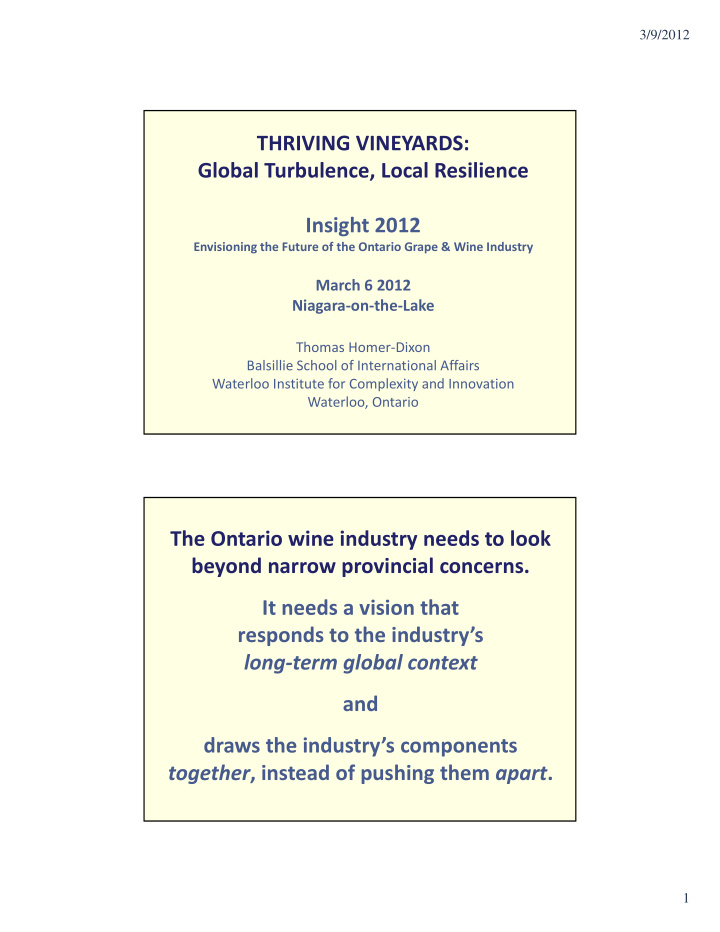



3/9/2012 THRIVING VINEYARDS: Global Turbulence, Local Resilience Insight 2012 Envisioning the Future of the Ontario Grape & Wine Industry March 6 2012 Niagara ‐ on ‐ the ‐ Lake Thomas Homer ‐ Dixon Balsillie School of International Affairs Waterloo Institute for Complexity and Innovation Waterloo, Ontario The Ontario wine industry needs to look beyond narrow provincial concerns. It needs a vision that responds to the industry’s long ‐ term global context and draws the industry’s components together , instead of pushing them apart . 1
3/9/2012 The challenges facing the Ontario wine industry are a microcosm of the challenges facing Ontario’s economy overall in a rapidly changing – and ferociously competitive – global context. Most of Ontario’s economic challenges in the present arise from: • increasing competitiveness of imports, and • decreasing demand for our goods and services within unstable global markets 2
3/9/2012 Key factors: • Strong Canadian dollar’s impact on imports and exports • Lingering affects of global financial crisis on consumer demand • Extreme global competition in a deflationary macro ‐ economic environment Some of the likely future economic challenges are widely recognized • Wealth and income polarization • Demographic shifts: aging and more ethnically diverse populations • Ongoing de ‐ leveraging • Continued economic volatility 3
3/9/2012 But other future economic challenges are less recognized especially those arising from shifts in costs and availability of resource and environmental inputs Key factors: • Rising energy costs worldwide, especially for transportation energy Will have chronic recessionary impact and become a brake on globalization of (low ‐ value density) material trade Possible increased regionalization of global economy • Climate change and more frequent extreme weather events 4
3/9/2012 Overall, we’re going to see more economic surprises and shocks arising from rising stress on increasingly complex interlinked global economic, ecological, and resource systems. CONVERGENCE and OVERLOAD x x Multiple converging Overload stresses x x 5
3/9/2012 Larger, wealthier populations x Environmental damage x Global Rising energy food prices crisis x Climate change x Inadequate agricultural research ENERGY STRESS 6
3/9/2012 7
3/9/2012 CLIMATE STRESS Decadal mean surface temperature anomalies relative to base period 1951 ‐ 1980. Source: update of Hansen et al., GISS analysis of surface temperature change. J. Geophys. Res. 104 , 30997 ‐ 31022, 1999. 8
3/9/2012 Partly because of this rising stress, we now live in a world of constant SURPRISE 9
3/9/2012 10
3/9/2012 Rising Frequency of Extreme Events Frequency Maximum Daytime Temperature 11
3/9/2012 Rising Frequency of Extreme Events Frequency Y 1 X Maximum Daytime Temperature Rising Frequency of Extreme Events Frequency Y 1 X Maximum Daytime Temperature 12
3/9/2012 Rising Frequency of Extreme Events Y 2 Frequency Y 1 X Maximum Daytime Temperature Battisti and Naylor, “Historical warnings of future food insecurity with unprecedented seasonal heat.” Science (9 January 2009): 240 ‐ 44 13
3/9/2012 Battisti and Naylor, “Historical warnings of future food insecurity with unprecedented seasonal heat.” Science (9 January 2009): 240 ‐ 44 So we shouldn’t be SURPRISED by SURPRISE 14
3/9/2012 In this new world, what should we do? ONE POSSIBLE RESPONSE: 15
3/9/2012 GET READY FOR A GPT TRANSITION GPT = General Purpose Technology Railroads Electricity Internal combustion engine Personal computer “Green” energy technologies? AS ENERGY PRICES RISE: • People, materials, and products will travel less • The cost differential between locally produced goods and those produced far away will decline and may even reverse • Production of goods with low value per unit mass will move closer to consumption; long ‐ distance trade of “heavy” products and materials will decline 16
3/9/2012 LOCAL IMPLICATIONS: • Populations will concentrate in small but dense communities with ready access to agricultural land • Stores will be smaller, embedded in communities, and within walking or biking distance • Work will be diverse, because communities will have to supply a larger fraction of all their needs . 17
3/9/2012 RESILIENT people, institutions and societies . . . have the capability to withstand shock without catastrophic failure have capacity for self ‐ reliance, and are creative in response to novel challenges. We can boost the resilience of our technological, economic, and social systems by: • Loosening coupling among their components • Ensuring self ‐ sufficiency in key inputs • Increasing diversity of system components • Decentralizing problem solving 18
3/9/2012 Connectivity and Resilience Resilience Connectivity • Support local agricultural production • Support marketing of local agricultural products • Now 19
3/9/2012 20
3/9/2012 Building resilience in the Ontario wine industry What does it mean? • Encourage diversity of producers, products, and varieties • Prepare for input supply shocks • Go local, go green • Simplify and reduce regulations ONTARIO’S ADVANTAGES (or why we should be glad we aren’t Alberta) Knowledge ‐ intensive economy Density of post ‐ secondary institutions Great trading location in North America Still good (albeit tired) infrastructure High quality of life Immigrant ‐ rich population Extraordinary agricultural resources Scarce energy resources; strong dollar 21
Recommend
More recommend